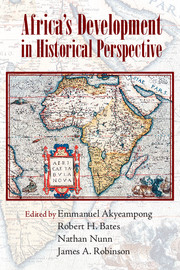Book contents
- Frontmatter
- Contents
- Author Biographies
- Acknowledgments
- Introduction
- Part I La Longue Durée
- Part II Culture, Entrepreneurship, and Development
- 5 Redistributive Pressures in Sub-Saharan Africa: Causes, Consequences, and Coping Strategies
- 6 Accumulation and Conspicuous Consumption: The Poverty of Entrepreneurship in Western Nigeria, ca. 1850–1930
- 7 Commerce, Credit, and Mobility in Late Nineteenth-Century Gold Coast: Changing Dynamics in Euro-African Trade
- 8 The Textile Industry of Eastern Africa in the Longue Durée
- 9 Explaining and Evaluating the Cash Crop Revolution in the “Peasant” Colonies of Tropical Africa, ca. 1890–ca.1930: Beyond “Vent for Surplus”
- 10 Reinventing the Wheel: The Economic Benefits of Wheeled Transportation in Early Colonial British West Africa
- 11 Mbanza Kongo/São Salvador: Culture and the Transformation of an African City, 1491 to 1670s
- Part III Institutions
- Part IV External Forces
- Index
- References
9 - Explaining and Evaluating the Cash Crop Revolution in the “Peasant” Colonies of Tropical Africa, ca. 1890–ca.1930: Beyond “Vent for Surplus”
Published online by Cambridge University Press: 05 September 2014
- Frontmatter
- Contents
- Author Biographies
- Acknowledgments
- Introduction
- Part I La Longue Durée
- Part II Culture, Entrepreneurship, and Development
- 5 Redistributive Pressures in Sub-Saharan Africa: Causes, Consequences, and Coping Strategies
- 6 Accumulation and Conspicuous Consumption: The Poverty of Entrepreneurship in Western Nigeria, ca. 1850–1930
- 7 Commerce, Credit, and Mobility in Late Nineteenth-Century Gold Coast: Changing Dynamics in Euro-African Trade
- 8 The Textile Industry of Eastern Africa in the Longue Durée
- 9 Explaining and Evaluating the Cash Crop Revolution in the “Peasant” Colonies of Tropical Africa, ca. 1890–ca.1930: Beyond “Vent for Surplus”
- 10 Reinventing the Wheel: The Economic Benefits of Wheeled Transportation in Early Colonial British West Africa
- 11 Mbanza Kongo/São Salvador: Culture and the Transformation of an African City, 1491 to 1670s
- Part III Institutions
- Part IV External Forces
- Index
- References
Summary
The fundamental economic change of the colonial era in the so-called peasant colonies of tropical Africa – those in which no major appropriation of agricultural land for use by European settlers or concessionaires occurred – was the massive expansion of export agriculture in areas with favorable land quality and location. The timing varied among and within individual colonies, but in general the fastest growth in the volume of agricultural exports took place during the early decades of colonial rule, ca. 1890 to ca. 1930, especially during the twenty years or so immediately preceding the First World War. In many areas, African agricultural exports had begun before the colonial occupation; in a few, such as northern Nigeria, with groundnuts (peanuts), it followed it. But even where it was already established, export agriculture expanded greatly during colonial rule. This expansion was associated with infrastructural innovation, especially the introduction of mechanized transport. It was also associated with institutional changes. The most important of these was the emergence of a migrant-labor system that channeled workers into the areas suited to export agriculture from the more distant and/or drier parts of the same or neighboring colonies.
The cash crop revolution is evidently a key episode in the economic history of Africa, defining the structure of most of the nonsettler economies. It is also particularly worthy of attention for students of comparative and long-term economic development. Sub-Saharan economies have often been thought of as static: at least before colonial rule, and perhaps during and since. Specialists know that there have been episodes of economic growth, albeit often sustained for just a few decades, in parts of the region during all these eras (e.g., Austin 2008; Berthélemy and Söderling 2001; Jerven 2010; Manning 1982). In this respect, the cash crop revolution is especially significant for several reasons. First, it was unusually widespread geographically. Second, in some areas for certain commodities, the speed of “takeoff” was dramatic. Third, production was carried out almost entirely by Africans; and, where they existed at all, European rivals failed in competition (e.g., Austin 1996). Thus research into this episode may be particularly useful as a means of testing long-term generalizations about the sources of stagnation or change in indigenous economic behavior.
- Type
- Chapter
- Information
- Africa's Development in Historical Perspective , pp. 295 - 320Publisher: Cambridge University PressPrint publication year: 2014
References
- 10
- Cited by



